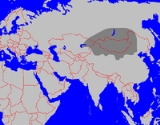
Toumen
Encyclopedia
Touman – was the earliest known Xiongnu
chanyu
(匈奴單于), reigning from c. 220 to 209 BCE. The name Touman (*Tumen
) is likely related to Middle Chinese
*muan, West Tokharian t(u)māne, Old Turkic/Mongolian
tümen, Modern Persian tumân, all meaning '10,000', a myriad).
By the time the Qin Dynasty conquered the other six states and began its reign over a unified China in 221 BCE, the nomadic Xiongnu had grown into a powerful invading force in the north and started expanding both east and west.
At the time the Donghu
(東胡) or 'Eastern Barbarians' were very powerful and the Yuezhi
flourishing. Emperor Qin Shi Huang
, the first emperor of the Qin Dynasty, sent a 100,000-strong army headed by General Meng Tian
to drive the Xiongnu northward for 1,000 li (about 416 km).
Some time after the death of Meng Tian in 210 BCE, the Xiongnu "once again began to infiltrate south of the bend of the Yellow River until they had established themselves along the old border of China."
Touman, wishing to favour a son of another consort, sent his eldest son, Modu (冒頓), as a hostage to the Yuezhi, and then made a sudden attack on them. The Yuezhi were about to kill Modu when he managed to steal a fast horse and escape back to the Xiongnu.
Touman, impressed with his bravery, put him in command of a force of 10,000 horsemen. However, Modu trained his men well and, in 209 BCE, killed his father and, after killing his stepmother, younger brother, and the high officials who refused to take orders from him, established himself as Chanyu.
With his new combined military force, Modu was able to establish the Xiongnu empire.
Xiongnu
The Xiongnu were ancient nomadic-based people that formed a state or confederation north of the agriculture-based empire of the Han Dynasty. Most of the information on the Xiongnu comes from Chinese sources...
chanyu
Chanyu
Chanyu , was the title used by the nomadic supreme rulers of Middle and Central Asia for 8 centuries, starting...
(匈奴單于), reigning from c. 220 to 209 BCE. The name Touman (*Tumen
Tumen
Tumen or Tümen was a part of the decimal system used by Turkic and Mongol peoples to organize their armies. Tumen is an army unit of 10,000 soldiers...
) is likely related to Middle Chinese
Middle Chinese
Middle Chinese , also called Ancient Chinese by the linguist Bernhard Karlgren, refers to the Chinese language spoken during Southern and Northern Dynasties and the Sui, Tang, and Song dynasties...
*muan, West Tokharian t(u)māne, Old Turkic/Mongolian
Mongolian language
The Mongolian language is the official language of Mongolia and the best-known member of the Mongolic language family. The number of speakers across all its dialects may be 5.2 million, including the vast majority of the residents of Mongolia and many of the Mongolian residents of the Inner...
tümen, Modern Persian tumân, all meaning '10,000', a myriad).
By the time the Qin Dynasty conquered the other six states and began its reign over a unified China in 221 BCE, the nomadic Xiongnu had grown into a powerful invading force in the north and started expanding both east and west.
At the time the Donghu
Donghu
Donghu was the name of a Mongolic nomadic tribal confederation that was first recorded from the 7th century BCE and was destroyed by the Xiongnu in 150 BCE. Donghu was later divided into the Wuhuan and Xianbei Confederations, from which the Mongols are derived...
(東胡) or 'Eastern Barbarians' were very powerful and the Yuezhi
Yuezhi
The Yuezhi, or Rouzhi , also known as the Da Yuezhi or Da Rouzhi , were an ancient Central Asian people....
flourishing. Emperor Qin Shi Huang
Qin Shi Huang
Qin Shi Huang , personal name Ying Zheng , was king of the Chinese State of Qin from 246 BC to 221 BC during the Warring States Period. He became the first emperor of a unified China in 221 BC...
, the first emperor of the Qin Dynasty, sent a 100,000-strong army headed by General Meng Tian
Meng Tian
Meng Tian was a general of the Qin Dynasty who distinguished himself in campaigns against the Xiongnu and in the construction of the Great Wall of China. He was the elder brother of Meng Yi. He descended from a great line of military generals and architects...
to drive the Xiongnu northward for 1,000 li (about 416 km).
- "Touman, unable to hold out against the Qin forces, had withdrawn to the far north, where he held out for over ten years."
Some time after the death of Meng Tian in 210 BCE, the Xiongnu "once again began to infiltrate south of the bend of the Yellow River until they had established themselves along the old border of China."
Touman, wishing to favour a son of another consort, sent his eldest son, Modu (冒頓), as a hostage to the Yuezhi, and then made a sudden attack on them. The Yuezhi were about to kill Modu when he managed to steal a fast horse and escape back to the Xiongnu.
Touman, impressed with his bravery, put him in command of a force of 10,000 horsemen. However, Modu trained his men well and, in 209 BCE, killed his father and, after killing his stepmother, younger brother, and the high officials who refused to take orders from him, established himself as Chanyu.
With his new combined military force, Modu was able to establish the Xiongnu empire.

